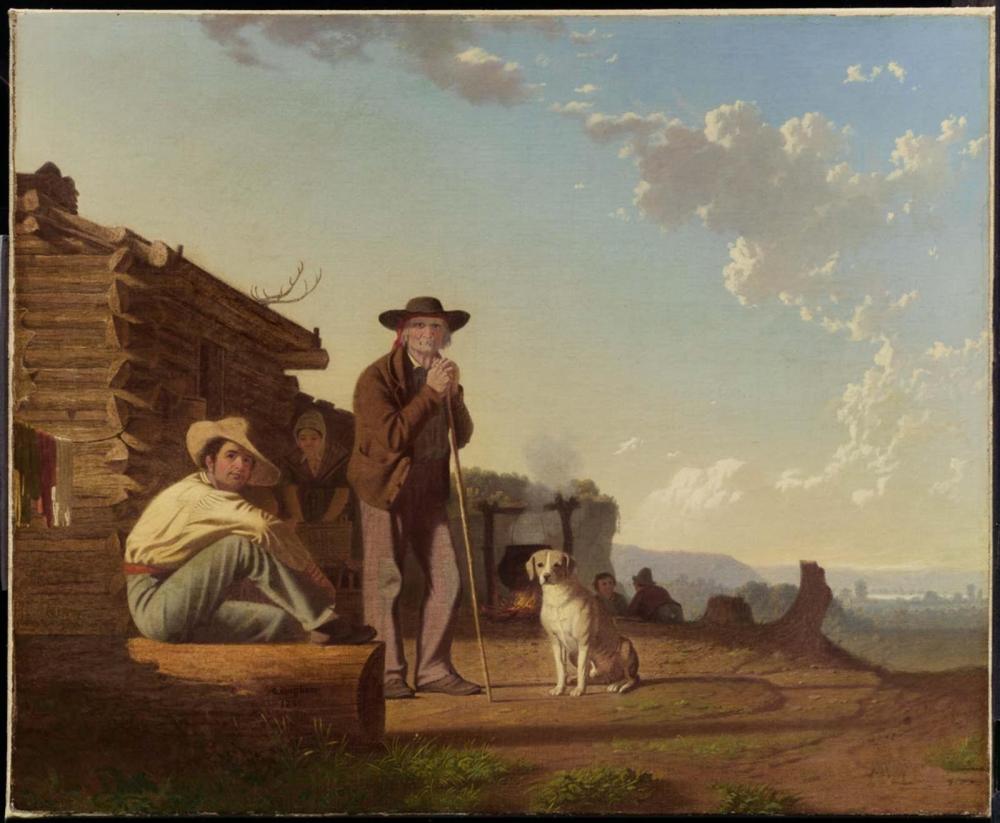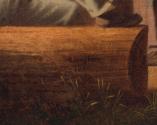Advanced Search
The Squatters
George Caleb Bingham (American, 1811–1879)
1850
Medium/Technique
Oil on canvas
Dimensions
58.74 x 71.75 cm (23 1/8 x 28 1/4 in.)
Credit Line
Bequest of Henry Lee Shattuck in memory of the late Ralph W. Gray
Accession Number1971.154
CollectionsAmericas
ClassificationsPaintings
Missouri painter George Caleb Bingham specialized in images of life on the western frontier. He was self-taught, acquiring information about technique, composition, anatomy, and pose from engravings, drawings, and casts of antique sculpture he purchased on a trip east in the late 1830s. He painted many portraits, mostly of his middle-class Missouri neighbors, but his most admired works, both in his lifetime and now, are his idyllic views of boatmen on the placid Missouri River and his sharply satiric scenes of elections in small towns.
When Bingham sent The Squatters to the American Art-Union (an exhibition and auction house in New York City), he provided his east-coast audience with the following explanation of the picture's cast of characters: "The Squatters as a class, are not fond of the toil of agriculture, but erect their rude cabins upon those remote portions of the national domain, when the abundant game supplies their phisical [sic] wants. When this source of subsistence becomes diminished in consequence of increasing settlements around they usually sell out their slight improvement, with their 'preemption title' to the land, and again follow the receding footsteps of the Savage."
Although Bingham's description might make the squatters seem predatory, they were in fact an important part of the process of settling the west. At mid-century, these pioneers claimed new territory by "squatting" on, or occupying, it for a year or two. They would then abandon the land to a second group of settlers who would farm it and establish communities. The squatters were admired for their independence, and to small farmers and businessmen back east they represented the allure of the frontier. In 1843, the New York Tribune noted that, "Fearlessness, hospitality and independent frankness, united with restless enterprise and unquenchable thirst for novelty and change are the peculiar characteristics of the Western pioneer…"
Bingham's own admiration for the squatters was tempered by his political ambitions. A staunch Whig, he ran unsuccessfully for state legislature in 1846 and blamed his defeat, in part, on the squatters in his district, who consistently voted Democratic. Nonetheless, he painted them with understanding, if not sympathy. A young man, an old man, and their dog form a pyramid in the foreground-theirs is a strong and stable family unit, however footloose their lifestyle. The patriarch looks out at the viewer somewhat suspiciously, while the young man's expression is mild and open. In the background, in shadow, a woman washes clothes, while boys play near her boiling kettle. And just beyond the little rise on which the squatters have built their rude cabin is a handsome river valley, bathed in golden light that conveys the attraction of the open spaces farther west.
This text was adapted from Davis, et al., MFA Highlights: American Painting (Boston, 2003) available at www.mfashop.com/mfa-publications.html.
When Bingham sent The Squatters to the American Art-Union (an exhibition and auction house in New York City), he provided his east-coast audience with the following explanation of the picture's cast of characters: "The Squatters as a class, are not fond of the toil of agriculture, but erect their rude cabins upon those remote portions of the national domain, when the abundant game supplies their phisical [sic] wants. When this source of subsistence becomes diminished in consequence of increasing settlements around they usually sell out their slight improvement, with their 'preemption title' to the land, and again follow the receding footsteps of the Savage."
Although Bingham's description might make the squatters seem predatory, they were in fact an important part of the process of settling the west. At mid-century, these pioneers claimed new territory by "squatting" on, or occupying, it for a year or two. They would then abandon the land to a second group of settlers who would farm it and establish communities. The squatters were admired for their independence, and to small farmers and businessmen back east they represented the allure of the frontier. In 1843, the New York Tribune noted that, "Fearlessness, hospitality and independent frankness, united with restless enterprise and unquenchable thirst for novelty and change are the peculiar characteristics of the Western pioneer…"
Bingham's own admiration for the squatters was tempered by his political ambitions. A staunch Whig, he ran unsuccessfully for state legislature in 1846 and blamed his defeat, in part, on the squatters in his district, who consistently voted Democratic. Nonetheless, he painted them with understanding, if not sympathy. A young man, an old man, and their dog form a pyramid in the foreground-theirs is a strong and stable family unit, however footloose their lifestyle. The patriarch looks out at the viewer somewhat suspiciously, while the young man's expression is mild and open. In the background, in shadow, a woman washes clothes, while boys play near her boiling kettle. And just beyond the little rise on which the squatters have built their rude cabin is a handsome river valley, bathed in golden light that conveys the attraction of the open spaces farther west.
This text was adapted from Davis, et al., MFA Highlights: American Painting (Boston, 2003) available at www.mfashop.com/mfa-publications.html.
InscriptionsLower left, on log: [G.] C. Bingham./1850.
Provenance1851, sold by the artist to American Art Union for $125; 1852, bought by N. P. Hood for $85 at the American Art Union auction [1]. Mrs. George Thomson, Philadelphia, Pa. (who inherited it from her father, a gilder employed by the James S. Earle Galleries of Philadelphia) [2]. By 1937, with Charles D. Childs, Boston, Mass.; 1937, sold by Charles D. Childs to Henry L. Shattuck (1879-1971), Brookline, Mass.; 1971, bequest of Henry L. Shattuck to the MFA. (Accession Date: April 14, 1971)
[1] See John Francis McDermott, "Another Bingham Found: 'The Squatters'," Art Quarterly, vol. 19, 1956, pp. 68-71.
[2] See E. Maurice Bloch, George Caleb Bingham: A Catalogue Raisonne, Berkeley and Los Angeles: University of California Press, 1967, p. 75.
[1] See John Francis McDermott, "Another Bingham Found: 'The Squatters'," Art Quarterly, vol. 19, 1956, pp. 68-71.
[2] See E. Maurice Bloch, George Caleb Bingham: A Catalogue Raisonne, Berkeley and Los Angeles: University of California Press, 1967, p. 75.



